Potential role of transient receptor potential channel M5 in sensing putative pheromones in mouse olfactory sensory neurons
- PMID: 23613997
- PMCID: PMC3628705
- DOI: 10.1371/journal.pone.0061990
Potential role of transient receptor potential channel M5 in sensing putative pheromones in mouse olfactory sensory neurons
Abstract
Based on pharmacological studies of chemosensory transduction in transient receptor potential channel M5 (TRPM5) knockout mice it was hypothesized that this channel is involved in transduction for a subset of putative pheromones in mouse olfactory sensory neurons (OSNs). Yet, in the same study an electroolfactogram (EOG) in the mouse olfactory epithelium showed no significant difference in the responses to pheromones (and odors) between wild type and TRPM5 knockout mice. Here we show that the number of OSNs expressing TRPM5 is increased by unilateral naris occlusion. Importantly, EOG experiments show that mice lacking TRPM5 show a decreased response in the occluded epithelia to putative pheromones as opposed to wild type mice that show no change upon unilateral naris occlusion. This evidence indicates that under decreased olfactory sensory input TRPM5 plays a role in mediating putative pheromone transduction. Furthermore, we demonstrate that cyclic nucleotide gated channel A2 knockout (CNGA2-KO) mice that show substantially decreased or absent responses to odors and pheromones also have elevated levels of TRPM5 compared to wild type mice. Taken together, our evidence suggests that TRPM5 plays a role in mediating transduction for putative pheromones under conditions of reduced chemosensory input.
Conflict of interest statement
Figures
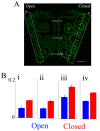

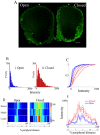
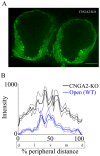
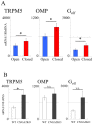
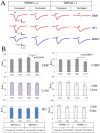
References
-
- Buck LB (2005) Unraveling the sense of smell (Nobel lecture). AngewChemIntEd Engl 44: 6128–6140. - PubMed
-
- Axel R (2005) Scents and sensibility: a molecular logic of olfactory perception (Nobel lecture). AngewChemIntEd Engl 44: 6110–6127. - PubMed
-
- Jones DT, Reed RR (1989) Golf: an olfactory neuron specific-G protein involved in odorant signal transduction. Science 244: 790–795. - PubMed
-
- Bakalyar HA, Reed RR (1990) Identification of a specialized adenylyl cyclase that may mediate odorant detection. Science 250: 1403–1406. - PubMed
Publication types
MeSH terms
Substances
Grants and funding
LinkOut - more resources
Full Text Sources
Other Literature Sources
Molecular Biology Databases
Research Materials

